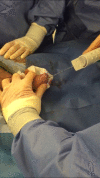Treatment-resistant priapism associated with long-term low-molecular-weight heparin
- PMID: 33795288
- PMCID: PMC8021742
- DOI: 10.1136/bcr-2021-241897
Treatment-resistant priapism associated with long-term low-molecular-weight heparin
Abstract
This case report summarises the case of a 56-year-old man with low-flow, ischaemic priapism requiring urgent insertion of a penile prosthesis following prophylactic anticoagulation with tinzaparin. Low-molecular-weight heparin (LMWH) has been proposed as a cause of ischaemic priapism, although reported cases of this are rare. This particular side effect of tinzaparin has been reported once in a case report in 2018, and there are scant other reports of LMWH-induced priapism. This case was refractory to the full treatment algorithm, including multiple aspirations, phenylephrine injection, cavernosal shunt and required transfer for implantation of a penile prosthesis. Only one other case of such a severe case of priapism has been documented, involving LMWH and warfarin. Documented evidence of possible causes of priapism are vital, given the rarity of this condition, the frequency of LMWH and the potentially devastating complications.
Keywords: haematology (drugs and medicines); urology.
© BMJ Publishing Group Limited 2021. No commercial re-use. See rights and permissions. Published by BMJ.
Conflict of interest statement
Competing interests: None declared.
Figures
References
Publication types
MeSH terms
Substances
LinkOut - more resources
Full Text Sources
Other Literature Sources


